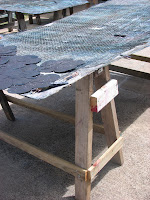The Tahitian pareo has been around for a very long time. From its modest and practical origins, the pareo evolved from Tahitian tapa which adorned and clothed the islanders before European contact. A tiputa poncho, pareu and maro were the forerunners of post-European dress in the islands.
 The history and origins of the modern day pareo has gone through changes throughout the ages. It progressed from manual printing, block printing and modern textile printing. Yet the art and creativity still remains the core.
The history and origins of the modern day pareo has gone through changes throughout the ages. It progressed from manual printing, block printing and modern textile printing. Yet the art and creativity still remains the core.Auntie Ura has kept this art alive and well. She is one of the few who have continued this artform. It's an art she is most proud of and enjoys making and knowing that others enjoy her work as much as she does. Originally from Tahiti, she has spent a large part of her life in Hawaii. She has made pareos for almost 30 years. We're blessed to be able to have her create her "Mahana" pareos for us here at Black Pearl Designs.
With a creative flair, Auntie Ura prewashes the fabric and dyes the pareos in photo sensitive dyes, which were introduced from merchants visiting Tahiti from France. It is a unique dye that when exposed to sunlight, creates a fabric effect similar to the batik and tie dye. This, however, can be a softer look. Anything placed on top of the dyed fabric will leave a lighter impression. Anything under the fabric will leave a darker impression.
 One of the fun effects that can change the pareos' appearance is the use of Hawaiian sea salt. When spread out over the pareo, it absorbs some of the dye to create variations in the dye intensity. Combine it with leaves and flower silhouettes with intricate patterns, and you have a totally unique piece of wearable art. The pareos are laid out in the sun until the dye is set and then dried on clothes lines using the cool tradewinds. It's a Kodak moment as you pass by watching all the pareos drying flapping in the wind.
One of the fun effects that can change the pareos' appearance is the use of Hawaiian sea salt. When spread out over the pareo, it absorbs some of the dye to create variations in the dye intensity. Combine it with leaves and flower silhouettes with intricate patterns, and you have a totally unique piece of wearable art. The pareos are laid out in the sun until the dye is set and then dried on clothes lines using the cool tradewinds. It's a Kodak moment as you pass by watching all the pareos drying flapping in the wind.Together with all the labor and time that goes into making these pareos and mother nature, each Mahana Pareo is a unique piece of wearable art. Pareo making is one of Tahiti's only surviving folk arts. It is heartening to have visitors in Tahiti purchase the handmade pareos to help the traditions of the native people live on.

No comments:
Post a Comment